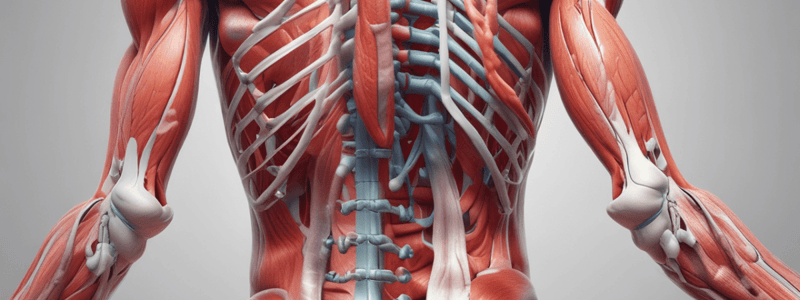Podcast
Questions and Answers
What is the purpose of the Glycogen-lactic acid system?
What is the purpose of the Glycogen-lactic acid system?
- Generate NAD+ to feed back into glycolysis (correct)
- Promote the accumulation of lactic acid in the muscle cells
- Convert pyruvate into lactic acid in the absence of oxygen
- Produce ATP through aerobic respiration
When there is insufficient oxygen, pyruvate is converted into:
When there is insufficient oxygen, pyruvate is converted into:
- Glycogen
- ATP
- Lactic acid (correct)
- Glucose
What does the Cori cycle help to achieve?
What does the Cori cycle help to achieve?
- Regenerate NAD+ (correct)
- Enhance ATP production in mitochondria
- Produce lactic acid in muscle cells
- Convert glucose into glycogen
In Type IIB fibers with minimal mitochondria, what is the impact on energy production?
In Type IIB fibers with minimal mitochondria, what is the impact on energy production?
What is the net loss or gain of ATP in the Cori cycle overall?
What is the net loss or gain of ATP in the Cori cycle overall?
What happens to lactic acid in the Glycogen-lactic acid system?
What happens to lactic acid in the Glycogen-lactic acid system?
What is the term for the process where new sarcomeres are added at the ends of muscle fibers due to stretching?
What is the term for the process where new sarcomeres are added at the ends of muscle fibers due to stretching?
In extreme conditions of muscle force generation, what happens to the number of muscle fibers?
In extreme conditions of muscle force generation, what happens to the number of muscle fibers?
What can cause the disappearance of sarcomeres at the ends of muscle fibers?
What can cause the disappearance of sarcomeres at the ends of muscle fibers?
Which factor contributes to muscle hypertrophy?
Which factor contributes to muscle hypertrophy?
Which of the following statements about force production in muscle fibers is correct?
Which of the following statements about force production in muscle fibers is correct?
Which of the following characteristics is associated with slow-twitch muscle fibers?
Which of the following characteristics is associated with slow-twitch muscle fibers?
Which of the following fuel sources is primarily used by fast-twitch muscle fibers?
Which of the following fuel sources is primarily used by fast-twitch muscle fibers?
Based on the recorded percentages of muscle fiber types in different athletes, which athlete group is most likely to have the highest proportion of fast-twitch fibers?
Based on the recorded percentages of muscle fiber types in different athletes, which athlete group is most likely to have the highest proportion of fast-twitch fibers?
Which of the following metabolic systems is responsible for the rapid resynthesis of ATP during short, high-intensity exercises?
Which of the following metabolic systems is responsible for the rapid resynthesis of ATP during short, high-intensity exercises?
Which of the following statements about the proportions of muscle fiber types is correct?
Which of the following statements about the proportions of muscle fiber types is correct?
Which of the following characteristics best describes Type I (slow-twitch) muscle fibers?
Which of the following characteristics best describes Type I (slow-twitch) muscle fibers?
Which of the following muscle fiber types is best suited for high-force, quick-fatigue activities?
Which of the following muscle fiber types is best suited for high-force, quick-fatigue activities?
Which of the following statements about muscle fiber types is NOT true?
Which of the following statements about muscle fiber types is NOT true?
Based on the information provided, which of the following statements about the motor neuron size and muscle fiber types is correct?
Based on the information provided, which of the following statements about the motor neuron size and muscle fiber types is correct?
Which of the following statements best describes the difference between Type IIA and Type IIB muscle fibers?
Which of the following statements best describes the difference between Type IIA and Type IIB muscle fibers?
What is the primary cause of muscle atrophy?
What is the primary cause of muscle atrophy?
Which of the following is NOT a potential cause of muscle atrophy?
Which of the following is NOT a potential cause of muscle atrophy?
In the acute or subacute stages of muscle atrophy, which of the following occurs?
In the acute or subacute stages of muscle atrophy, which of the following occurs?
If contractile signals return after a period of muscle atrophy, how long may it take for full return to function?
If contractile signals return after a period of muscle atrophy, how long may it take for full return to function?
In the final stages of chronic muscle atrophy, what happens to the muscle fibers?
In the final stages of chronic muscle atrophy, what happens to the muscle fibers?
What is the primary difference between lengthening hyperplasia and hypertrophy in skeletal muscle remodeling?
What is the primary difference between lengthening hyperplasia and hypertrophy in skeletal muscle remodeling?
Flashcards are hidden until you start studying




